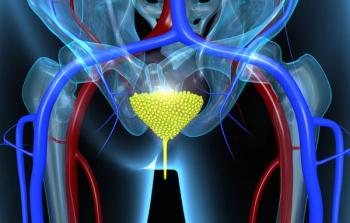
177Lu/SBRT Improves PFS in Oligorecurrent Hormone-Sensitive Prostate Cancer
In the 177Lu plus SBRT arm, the median PFS was 17.6 months vs 7.4 months in the SBRT alone arm for patients with oligorecurrent HSPC.
Progression-free survival (PFS) was significantly improved when 177Lu-PNT2002 (177Lu) was added to stereotactic body radiotherapy (SBRT) for patients with oligorecurrent hormone-sensitive prostate cancer (HSPC), according to results from the phase 2 LUNAR trial (NCT05496959) published in the Journal of Clinical Oncology.
The median follow-up was 22 months, and 75% of patients overall had progression events. The median PFS in the SBRT alone group was 7.4 months (95% CI, 6.0-13.5) vs 17.6 months (95% CI, 15-not reached [NR]) in the 177Lu plus SBRT arm (HR, 0.37; 95% CI, 0.22-0.61; P <.0001).
In the combination arm, all 45 patients were given both cycles of 177Lu with a median interval of 8 weeks between cycles. Of note, 12 patients had a median prostate specific antigen (PSA) increase of 18.2%, 32 patients had a median decrease of 51.9%, and 1 patient had no change in PSA. On the post-177Lu prostate-specific membrane antigen (PSMA)/PET scan, there was a 30% reduction or more in the size of at least 1 target lesion in 16% of patients, while 4% had a complete resolution of all disease radiographically.
There was 1 patient who had progressive disease on the post-177Lu interval PSMA PET/CT and was not given SBRT. The remaining 44 patients were given SBRT after a median of 5.9 weeks from the second cycle of 177Lu. There was 1 patient who had a lesion close to the proximal bronchial treat with an 8-fraction radiotherapy regimen compared with 5 fractions.
In the SBRT group, 34 patients vs 23 in the combination group had new lesions on the PSMA PET/CT and triggered the protocol-defined PSA rises, and 64 of 65 progression events were due to new lesions. Two patients receiving SBRT had in-field progressions, while no patient in the combination group experienced that.
In 11 patients in the SBRT arm vs 10 in the combination arm, upstaging at progression occurred (P = .74), with further upstaging occurring in 9 vs 3 patients (P = .13).
Salvage hormonal therapy was used when progression occurred in 38% of patients in the SBRT arm vs 20% in the combination arm. Ten patients in both groups were given salvage hormonal therapy with repeat SBRT. In 8 patients in the SBRT arm and 9 in the combination arm, repeat SBRT was given to all metastatic sites without hormonal therapy. The multidisciplinary care team was left to decide when or if to begin hormonal therapy. However, treatment was encouraged if there were new lesions on PSMA PET/CT or PSA exceeded 10.0 ng/mL.
There were 47 patients who were given salvage hormonal therapy, and 46 had new lesions via PSMA PET/CT, while only 1 patient in the combination arm was given new therapy without identifying new lesions or having a PSA of 10.0 ng/mL.
The median salvage hormonal therapy-free survival was 14.1 months (95% CI, 10.1-NR) in the SBRT alone arm vs 24.3 months (95% CI, 18-NR) in the combination arm (HR, 0.40; 95% CI, 0.22-0.71; P <.0001).
“This randomized phase 2 trial demonstrated that the addition of 2 cycles of 177Lu-PNT2002 to SBRT in patients with oligorecurrent HSPC improved PFS. To validate this benefit, a confirmatory phase 3 study with additional patients, a multicenter design, and the incorporation of blinded central readers with strict predefined criteria for lesion positivity is required to enhance the generalizability of these findings,” Amar U. Kishan, MD, professor with tenure and executive vice chair for the Department of Radiation Oncology at the David Geffen School of Medicine at UCLA and the UCLA Jonsson Comprehensive Cancer Center, and co-authors wrote in the study.
The trial enrolled 92 patients and randomly assigned them to either the SBRT arm (n = 47) or the 177Lu plus SBRT arm (n = 45). There were 5 patients in the SBRT arm who withdrew consent, but the trial continued with 42 patients in that arm. The median PSA at assignment was 1.1 ng/mL, and the median number of lesions per patients was 2. There were 37 patients who had a solitary lesion, 36 who had 2 to 3 lesions, and 14 who had 4 to 5.
SBRT was given in 1, 3, or 5 fractions of 16 to 18 Gy, 9 to 12 Gy, or 6 to 8 Gy. Dose de-escalation via protocol specification occurred in the combination arm. Two cycles of neoadjuvant 177Lu were given in the combination arm with a time interval of 8 weeks between cycles. Per cycle, the target injection activity was 6.8 GBq. After cycle 1, patients were imaged with CT scans at 4, 24 to 48, and 72 to 96 hours to characterize radiotracer pharmacokinetics. Four to 6 weeks after the second cycle, interval PSMA PET/CT occurred.
No significant adverse effect (AE) differences between arms were noted, and the only grade 3 AE was lymphopenia events in 4.8% of patients in the SBRT arm and 6.7% in the combination arm. Grade 1 events included dry mouth (5.6% vs 6.8%), and dry eye (0% vs 4.4%).
Reference
Kishan AU, Valle LF, Wilhalme H, et al. 177Lu-prostate-specific membrane antigen neoadjuvant to stereotactic ablative radiotherapy for oligorecurrent prostate cancer (LUNAR): an open-label, randomized, controlled, phase II study. J Clin Oncol. Published online November 12, 2025. doi:10.1200/JCO-25-01553
Newsletter
Stay up to date on recent advances in the multidisciplinary approach to cancer.






















































































